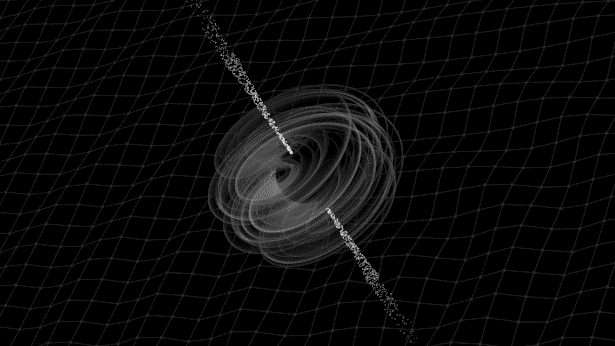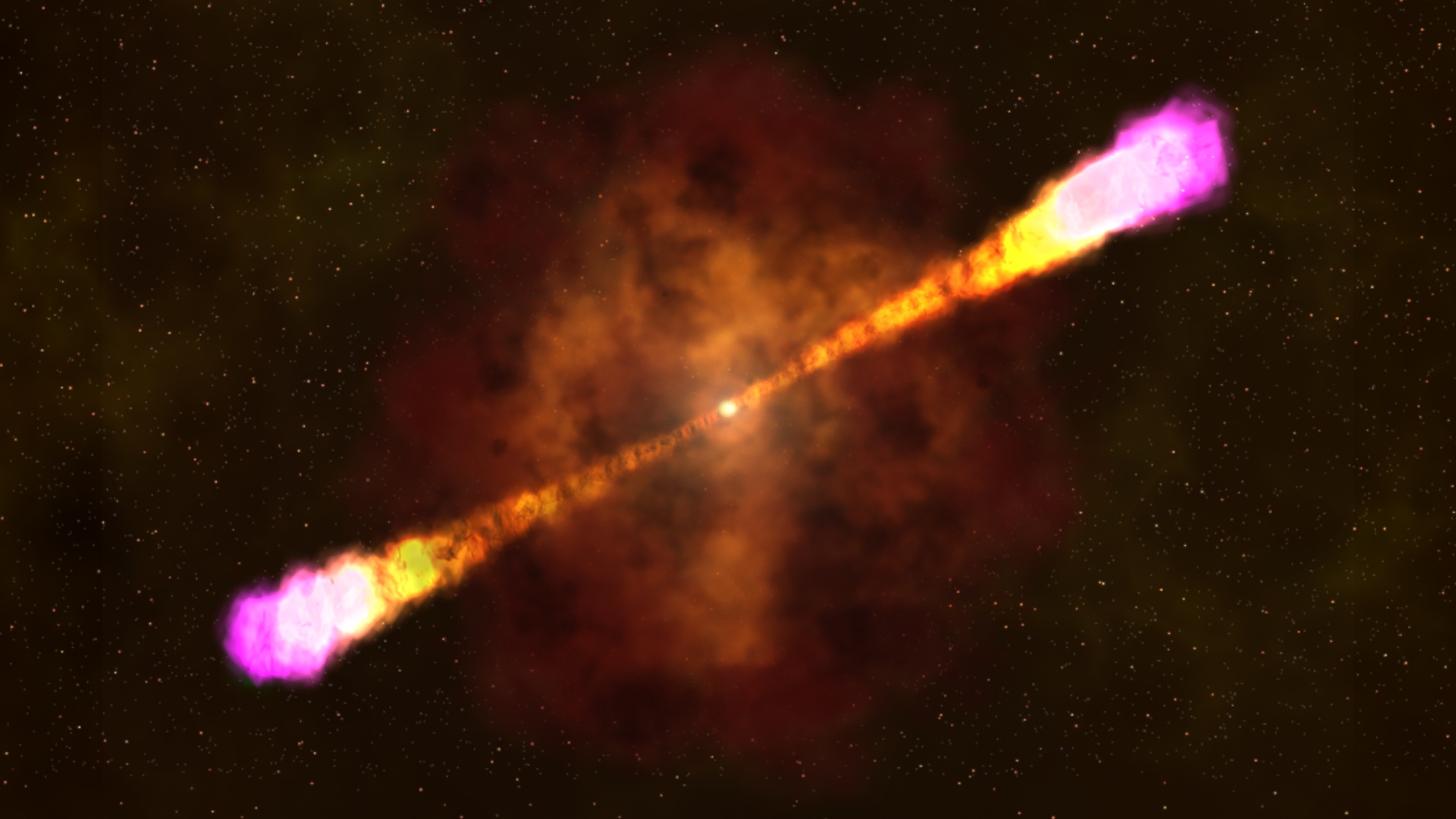After Black Holes Collide, a Puzzling Flash

On Sept. 14, 2015, at almost the exact same time that a pair of sprawling gravitational-wave detectors heard the last gasp of a collision between two black holes, another, more perplexing observation took place. Over 500 kilometers above the surface of the Earth, the orbiting Fermi Gamma-Ray Space Telescope logged a passing burst of gamma rays, a high-energy form of light. The signal was so slight that the NASA scientists who run the satellite didn’t notice it at first.
“[The gravitational-wave detector] LIGO saw a bright event, clear in their data, and we found a little blip in our data that’s really only credible because it happened so close in time to the gravitational wave,” said Valerie Connaughton, a member of the Fermi team.
On Feb. 11, the Fermi researchers posted a paper to the scientific preprint site arxiv.org describing the gamma-ray burst and speculating that it likely originated from the same black-hole merger that produced the gravitational waves observed by LIGO (the Laser Interferometer Gravitational-Wave Observatory). The correlation, which is far from certain, would upend entrenched assumptions in physics. Astrophysicists have long believed that black holes exist in a vacuum, as they tend to swallow up all nearby matter. This absence of matter means it should be impossible for two merging black holes to generate a flash of light.
“If you don’t have charged particles, you don’t have magnetic fields, and you can’t get electromagnetic radiation,” said Adam Burrows, an astrophysicist at Princeton University. “It’s too clean a system.”
But the gamma-ray burst detected by the Fermi satellite suggests that perhaps the neighborhood around a pair of black holes isn’t so empty after all. In the days since the Fermi team released their paper, a number of astrophysicists have hastened to propose theoretical explanations for how matter might persist around black holes in high enough concentrations to generate a gamma-ray burst. These theories involve flights of astrophysical imagination, pulled together in the wake of a historic event, to explain an observation of light that by all accounts should not have been there.

A Cosmic Coincidence?
Gamma rays fall at the very end of the electromagnetic spectrum. Of all the varieties of light, they have the shortest wavelengths, the highest frequency and the most energy — millions of times more energy than ultraviolet light, for example.
It takes extreme conditions to create that much energy, and only two known astrophysical events might do so. One is the collapse of a massive star into a black hole. As the stellar core falls in on itself, it shucks off its surrounding envelope of matter and forms violent jets of energy that propel that matter out into space at nearly the speed of light. These are the so-called “long gamma-ray bursts,” which account for about 80 percent of all gamma-ray bursts and typically last around 20 seconds.
The second mechanism for producing a gamma-ray burst is the merger of two very compact objects, such as a pair of neutron stars or a neutron star and a black hole. In the case of a star and a black hole, matter from the star forms a ring of material called an accretion disk around the black hole. As the material from the accretion disk falls into the black hole, jets of energy form along the axis of the merger. The result is a “short gamma-ray burst,” which typically lasts less than two seconds.
Gamma-ray bursts are the great pyrotechnic events of the universe, explosions on a scale that we can hardly imagine. They also provide astrophysicists with a way of seeing hidden cosmic events.
“Short gamma-ray bursts allow us to view dark objects,” Connaughton said. “When [these objects] merge, they produce a violent jet of energetic particles, and we see the violence in a phenomenon that would otherwise look very dark.”
On Sept. 14, Fermi detected a short, transient event that registered as a blip. It was so dim that the team did not even notice it at first. Later, when they learned that LIGO had detected a gravitational wave, they went back through their data to see if Fermi had seen anything interesting at the same time. Using an algorithm developed by Lindy Blackburn, an astronomer at the Harvard-Smithsonian Center for Astrophysics in Cambridge, Mass., and a member of the LIGO team, the Fermi researchers searched for faint blips in their noisy data. That’s when they saw it, a burst of gamma rays that arrived 0.4 seconds after the gravitational wave and lasted one second. It had characteristics of a typical short gamma-ray burst that, at its origin, contained 10,000 trillion times the amount of energy the sun produces over that same length of time.
Whether the gamma-ray burst was real, rather than a detection error, and whether, if real, it’s connected to the LIGO event has become a topic of intense debate in the weeks since the Fermi team published their paper.
The team has roughly established that the gamma-ray burst came from a 2,000-square-degree region of the sky. Combined with the 600-degree LIGO localization, the arrival direction is reduced to a 200-square-degree patch of sky, supporting the conclusion that the gamma-ray burst and the gravitational waves originated in the same place. The timing of the two events suggests this as well. Fermi detects blips of this magnitude about once every 10,000 seconds (or about every 2 hours and 47 minutes), making it unlikely, although not impossible, that the near-simultaneous observation of the gamma-ray burst and the gravitational waves was a coincidence.
“It’s a low-chance possibility, but it’s not impossible that this happened by chance,” Connaughton said. “That’s why we’re circumspect about claiming this is a counterpart to the LIGO event. It’s a ‘three-sigma’ result, not something we’d take to the bank under normal circumstances.” In fact, at the same time that Fermi noted the burst, another gamma-ray detector, the European Space Agency’s Integral satellite, observed nothing. “From our perspective, it is quite unlikely the event Fermi has detected is related to the gravitational-wave event,” said Carlo Ferrigno, a member of the Integral team.
More fundamentally, the Fermi team is being cautious about linking the two events because the merger of two black holes is simply not supposed to generate light. “Everything is in its favor, except for physics, which is a problem,” Connaughton said.
The physics does pose a problem — or at least a riddle.
Video: In this computer simulation, a rapidly rotating supermassive star collapses to form a pair of black holes that ultimately merge into one. A similar scenario has been used to explain how colliding black holes could create a gamma-ray burst.
“To produce a gamma-ray burst you need some conventional matter like an accretion disk around the merging object,” said John Ellis, a particle physicist at King’s College London. “I think it’s pretty clear if you’re talking about the merger of neutron stars you’d have that matter. It’s not so obvious around black holes.”
The accuracy of Fermi’s observation will be resolved over time. LIGO will presumably detect more gravitational waves. As it does so, the Fermi team will look for corresponding gamma-ray bursts. If they find them, they’ll know they’re onto something.
Building Bright Black Holes
In the meantime, astrophysicists have been trying to explain how there could be enough material around a pair of black holes to produce a gamma-ray burst. Bing Zhang, an astrophysicist at the University of Nevada, Las Vegas, has speculated that if one or both of the merging black holes contained a charge, that charge might be sufficient to create a magnetic field that could generate a gamma-ray burst. But according to the general consensus, astrophysical black holes should have no measurable charge.
Another proposal comes from Rosalba Perna, an astrophysicist at Stony Brook University. In a paper posted to arxiv.org on Feb. 16, she and two colleagues speculate that two massive stars locked together in a binary star system might both die, forming two black holes. As the second massive star in the system dies, debris from its envelope might fall back toward the core and settle into an accretion disk. Then, as a merger begins, the companion black hole would enter the other through this disk, powering a gamma-ray burst.
Avi Loeb, the chairman of the astronomy department at Harvard University, has offered a third possibility. In a paper posted to arxiv.org on Feb. 15 and subsequently accepted for publication in The Astrophysical Journal Letters, Loeb describes how a pair of black holes might originate simultaneously inside a star 100 times as large as the sun. As he envisions it, this massive star was originally created when two smaller stars combined. The conditions of that merger cause the massive star to spin very rapidly. When it eventually begins to collapse, the centrifugal force from the spin causes its core to break into two clumps in a dumbbell configuration, and each clump forms a black hole — with the two black holes gravitationally intertwined inside the remnants of the massive star.
“It’s sort of like a pair of twins in the belly of a pregnant mother, and as they come together, they make one black hole,” Loeb says.
The black holes in Loeb’s scenario eventually merge, and because the merger takes place inside a massive star, there would be plenty of material around to fuel a gamma-ray burst — in fact, Loeb imagines that as much as a whole solar mass would fall into the newly created black hole per second at the time of the merger.
Loeb’s paper is only the beginning of an effort to explain an observation that, if it holds up, would demand a new way of thinking from astrophysicists. A rapidly spinning, supermassive star of the kind at the center of his proposal has never been seen. Additionally, in scenarios where a star has a rapidly rotating inner core, the core doesn’t usually split into two dumbbells — it creates a flattened disc with spiral arms. Over the next year, Loeb and others will run computer simulations to determine whether it’s possible to generate the conditions described in his paper. Some of Loeb’s colleagues are skeptical that his scenario will end up working.
“Personally, I think this is a bit of a stretch,” said Burrows. “There are a few tooth fairies that have been concatenated here to explain what may be a spurious detection.”
Others think that Loeb’s paper points the field of astrophysics in the right direction, regardless of whether it ends up being correct.
“As always in science when there are important new discoveries, in this case LIGO, there’s a time of early speculation where people throw out ideas,” said Volker Bromm, an astrophysicist at the University of Texas, Austin. “I think Avi’s paper is excellent because it focuses people’s attention on what needs to be done. It’s definitely plausible.”
In time, the authenticity of the Fermi detection will become clear. If it does prove accurate, theories will eventually develop that explain how two black holes create a gamma-ray burst. They may resemble the ideas that have been proposed by Zhang, Perna and Loeb, or they may end up looking completely different. What’s clear is that post-LIGO, there is a lot of new science to be done. The rush to untangle the implications of the post-gravitational-wave world is already under way.
This article was reprinted on Wired.com.



